The meningococcal vaccine market is experiencing steady growth driven by rising immunization coverage, government-supported vaccination programs, and increasing awareness of meningococcal disease prevention. Current market dynamics reflect the growing adoption of advanced conjugate and combination vaccines that offer broader serogroup protection and longer-lasting immunity. Public health initiatives, supported by global health organizations, are strengthening vaccine accessibility across both developed and emerging economies.
The future outlook is characterized by expanding national immunization schedules, improved cold-chain logistics, and ongoing research focused on multivalent formulations. Market growth is being further reinforced by high disease burden in endemic regions and the push for mandatory vaccination in schools and healthcare settings.
The growth rationale is underpinned by advancements in vaccine technology, enhanced healthcare infrastructure, and strategic procurement programs that ensure consistent supply and equitable distribution Over the forecast period, continued collaboration between public health agencies and pharmaceutical manufacturers is expected to sustain market expansion and improve global immunization outcomes.
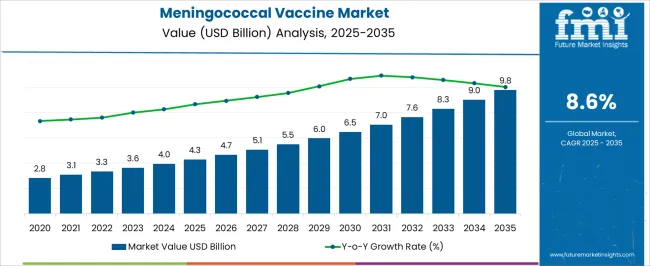
| Metric | Value |
|---|---|
| Meningococcal Vaccine Market Estimated Value in (2025 E) | USD 4.3 billion |
| Meningococcal Vaccine Market Forecast Value in (2035 F) | USD 9.8 billion |
| Forecast CAGR (2025 to 2035) | 8.6% |
The market is segmented by Product Type, Age Group, and End User and region. By Product Type, the market is divided into Conjugates and Polysaccharides. In terms of Age Group, the market is classified into Infants, Children, Adolescents, Young Adults, and Adults. Based on End User, the market is segmented into Public Health Agencies, Pharmacies, Community, Clinics, and Others. Regionally, the market is classified into North America, Latin America, Western Europe, Eastern Europe, Balkan & Baltic Countries, Russia & Belarus, Central Asia, East Asia, South Asia & Pacific, and the Middle East & Africa.
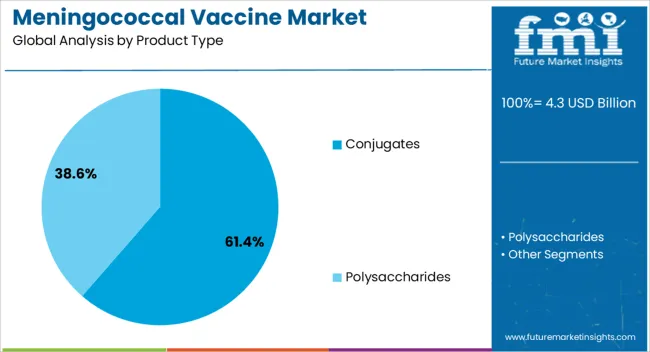
The conjugates segment, accounting for 61.4% of the product type category, has maintained its leading position owing to its superior immunogenicity, safety profile, and extended duration of protection. The segment’s dominance is supported by widespread inclusion of conjugate vaccines in national immunization programs and strong clinical efficacy across multiple serogroups.
Adoption has been reinforced by favorable recommendations from health authorities and growing preference for conjugate formulations in both pediatric and adult populations. Technological advancements in antigen conjugation and carrier protein optimization have further enhanced vaccine effectiveness.
Manufacturers are focusing on scalability and cost efficiency to meet increasing demand across global markets Continued expansion of immunization coverage in low- and middle-income countries, along with ongoing development of next-generation conjugate vaccines, is expected to sustain the segment’s market leadership throughout the forecast period.
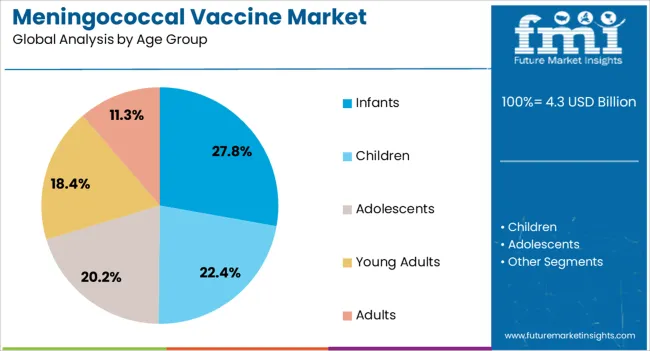
The infants segment, representing 27.8% of the age group category, has emerged as the primary target population due to the high vulnerability of infants to meningococcal infections and the critical importance of early immunization. Global health authorities have prioritized vaccination during infancy to prevent severe complications and reduce disease transmission.
The segment’s share is being reinforced by strong government support for early childhood immunization programs and increasing inclusion of meningococcal vaccines in routine pediatric schedules. Advances in vaccine formulation enabling improved efficacy and safety for young infants have further driven adoption.
Continuous monitoring and surveillance programs have enhanced vaccination compliance, while educational initiatives have raised parental awareness The segment is expected to maintain steady growth as ongoing public health investments and policy mandates ensure broader vaccine accessibility and higher immunization rates among newborn populations.
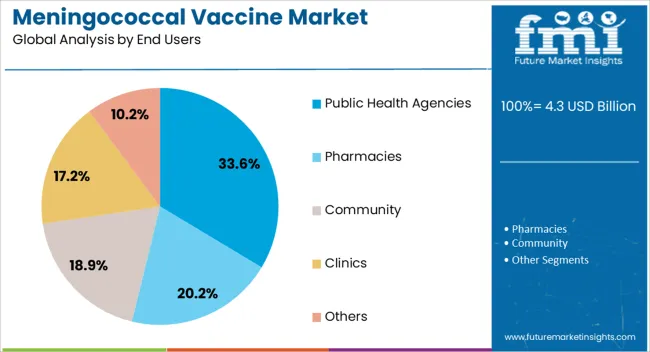
The public health agencies segment, holding 33.6% of the end user category, has remained the dominant distribution and implementation channel due to their pivotal role in large-scale vaccination campaigns and disease control programs. The segment’s leadership is supported by centralized procurement mechanisms, funding assistance from global health organizations, and efficient distribution infrastructure.
Public health agencies play a key role in ensuring equitable access to vaccines through mass immunization drives and outreach programs. Strategic collaborations with vaccine manufacturers have strengthened supply reliability and cost optimization.
Surveillance-based planning and targeted vaccination initiatives have improved coverage across high-risk populations As global health priorities continue to emphasize preventive immunization, the influence of public health agencies is expected to remain strong, sustaining their significant contribution to overall meningococcal vaccine market expansion.
Expansion of Vaccination Programs to Benefit Meningococcal Vaccine Market Growth
One crucial trend that is fueling the growth of meningococcal vaccine industry is the expansion of vaccination programs globally. Governments in various countries, with the help of private as well as public healthcare facilities, are increasingly including meningococcal vaccines in their national immunization schedules.
They are targeting not only infants and young children but also adolescents, college students, and travelers to regions where the disease is endemic.
Key Players are Developing New Vaccine Formulations
Post-pandemic, the pharmaceutical industry, across the world, has experienced a considerable transformation. Industry-giants are investing billions of dollars, which has LED to more research and development activities.
This trend is also observed to be applying for meningococcal vaccines. The newly formulated vaccines are more efficient, safe, and convenient to use. Their adoption is also touching the skies as they provide protection against multiple strains of meningococcal bacteria.
High Costs of Vaccines to Hamper Adoption
Despite its health benefits, the high costs of meningococcal vaccines is the largest restraint slowing down this industry. In low-income countries, the healthcare facilities are very poor. This has kept an enormous number of underserved populations away from the industry.
This trend is often observed in Middle East and African countries, where people generally have low per capita incomes. Key players in this region must collaborate with government and international organizations to address the affordability issue and improve access to vaccines.
Plunge in Demand for Vaccines due to Hesitancy and Misinformation
In countries with lower literacy rates and poor healthcare infrastructure, there is an observed trend of vaccine hesitancy and misinformation among the general populace. This can pose significant challenge in the growth of meningococcal vaccine industry.
There’s also a challenge of logistics when it comes to delivering vaccines to remote or underserved areas. This can result in lower vaccination coverage rates, leaving populations vulnerable to meningococcal disease outbreaks.
The meningococcal vaccine market, in the past, has been showcasing a stable growth rate before the pandemic hit the world. The governments in various countries, with the help of international organizations like the World Health Organization and the International Monetary Fund were organizing vaccination campaigns in underdeveloped countries. These initiatives were quite successful in mitigating the disease.
With the pandemic, the shift of almost all healthcare facilities shifted towards minimizing the spread of the virus. Healthcare and pharmaceutical companies also concentrated all their research on the development of new COVID-19 vaccines.
This negatively impacted the meningococcal industry. The closing of economies also meant that people had very little disposable income with them to afford costly vaccines.
With the opening of the economies, the world become accustomed to the new normal. Governments also continued their vaccination campaigns. Also, increased travel and the reopening of educational institutions spurred the demand for meningococcal vaccines, as these environments are prone to outbreaks. In the period between 2020 to 2025, the industry exhibited a CAGR of 7.9%.
In the time to come, as parents become increasingly aware of the fatality of meningococcal disease, the demand for these vaccines is very likely to rise noticeably.
The meningococcal vaccine market is categorized mainly into three: product type, age group, and distribution channel. The top two categories are discussed below.
Meningococcal vaccines come in two main types: conjugate and polysaccharide. As of 2025, the conjugate vaccine holds an industry share of 63.6%.
| Segment | Conjugate Vaccines (Product Type) |
|---|---|
| Value Share (2025) | 63.6% |
The clamor for conjugate vaccines as compared to the polysaccharide ones is touching the skies as they are more effective at providing long-lasting immunity and are better at reducing carriage and transmission of the bacteria.
These vaccines also offer a stronger immune response, especially in young children, and offer greater protection across diverse populations.
Key players are actively targeting their vaccine campaigns to almost all age groups. Among these, the adolescents and young adult age group holds the majority share of 30.3%, in 2025.
| Segment | Adolescents and Young Adults (Age Group) |
|---|---|
| Value Share (2025) | 30.3% |
The adolescent and young adult demographic is generating tremendous demand for meningococcal vaccines as these age groups are at higher risk for contracting meningococcal disease, particularly in settings like schools, colleges, and military barracks.
Besides this, awareness campaigns emphasizing the severe consequences of meningococcal disease are also compelling parents and young adults to prioritize vaccination.
The section describes the region-wise analysis of the global meningococcal vaccine market in the coming future.
According to these numbers, it can be predicted that Western countries like the United States of America and the United Kingdom are very likely to have a promising growth rate in the next ten years. China is also one of the most lucrative countries in this industry in the Asian region.
| Countries | CAGR 2025 to 2035 |
|---|---|
| The United Kingdom | 9.8% |
| The United States | 9.4% |
| China | 9.5% |
| France | 9.0% |
| Germany | 8.7% |
The United Kingdom also is very likely to exhibit a CAGR of 9.8% through 2035 in the meningococcal vaccine market.
The United Kingdom, as a country, is blessed with a robust healthcare system. The government as well as the private medicare system in the country actively takes up various initiatives to promote the overall well-being of the general populace.
The United Kingdom’s strong national immunization program that includes meningococcal vaccines as part of routine childhood and adolescent vaccinations is also fueling an excellent demand for the industrial growth of the meningococcal industry.
The United States is one of the most prominent countries when it comes to the meningococcal vaccine market. It is very likely to register a CAGR of 9.4% through 2035.
The United States government is very particular about the spread of meningococcal disease among its population, especially the young and school-going children.
They have even implemented mandatory meningococcal vaccination requirements for school and college entry. This is primarily done to ensure high vaccination coverage, which is in turn increasing the adoption of meningococcal vaccine.
The Chinese meningococcal industry is slated to show a 9.5% CAGR for the forecast period of 2025 to 2035.
The Chinese government, after the pandemic, has been emphasizing a lot on the general public’s overall well-being. This is the reason why the government is investing billions of dollars in the medical inclusivity of its population in the public healthcare system. This naturally has generated an enormous demand for meningococcal vaccines in the country.
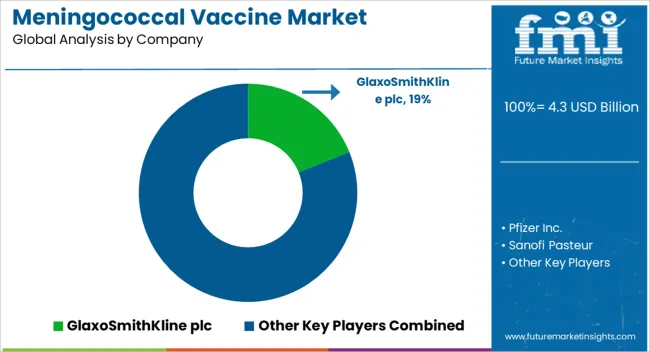
The competitive landscape of the global meningococcal vaccine market is primarily driven by innovations in vaccine formulations. The consumer base of the company in the industry totally depends on the efficiency, cost, and safety profile of the vaccine they formulate.
Companies are also tying up with government and international organizations to expand their market reach and ensure wider vaccine accessibility.
Some of the most prominent companies in the industry are GlaxoSmithKline plc, Pfizer Inc., Sanofi Pasteur, Merck & Co., Inc., and Novartis AG.
Industry Updates
The sector is bifurcated into polysaccharides and conjugates.
The industry is segmented into infants, children, adolescents, young adults, and adults.
The sector is segmented into, pharmacies, community, clinics, public health agencies, and others.
The industry is divided into North America, Latin America, Europe, Asia-Pacific, and the Middle East and Africa
The global meningococcal vaccine market is estimated to be valued at USD 4.3 billion in 2025.
The market size for the meningococcal vaccine market is projected to reach USD 9.8 billion by 2035.
The meningococcal vaccine market is expected to grow at a 8.6% CAGR between 2025 and 2035.
The key product types in meningococcal vaccine market are conjugates and polysaccharides.
In terms of age group, infants segment to command 35.7% share in the meningococcal vaccine market in 2025.






Our Research Products

The "Full Research Suite" delivers actionable market intel, deep dives on markets or technologies, so clients act faster, cut risk, and unlock growth.

The Leaderboard benchmarks and ranks top vendors, classifying them as Established Leaders, Leading Challengers, or Disruptors & Challengers.

Locates where complements amplify value and substitutes erode it, forecasting net impact by horizon

We deliver granular, decision-grade intel: market sizing, 5-year forecasts, pricing, adoption, usage, revenue, and operational KPIs—plus competitor tracking, regulation, and value chains—across 60 countries broadly.

Spot the shifts before they hit your P&L. We track inflection points, adoption curves, pricing moves, and ecosystem plays to show where demand is heading, why it is changing, and what to do next across high-growth markets and disruptive tech

Real-time reads of user behavior. We track shifting priorities, perceptions of today’s and next-gen services, and provider experience, then pace how fast tech moves from trial to adoption, blending buyer, consumer, and channel inputs with social signals (#WhySwitch, #UX).

Partner with our analyst team to build a custom report designed around your business priorities. From analysing market trends to assessing competitors or crafting bespoke datasets, we tailor insights to your needs.
Supplier Intelligence
Discovery & Profiling
Capacity & Footprint
Performance & Risk
Compliance & Governance
Commercial Readiness
Who Supplies Whom
Scorecards & Shortlists
Playbooks & Docs
Category Intelligence
Definition & Scope
Demand & Use Cases
Cost Drivers
Market Structure
Supply Chain Map
Trade & Policy
Operating Norms
Deliverables
Buyer Intelligence
Account Basics
Spend & Scope
Procurement Model
Vendor Requirements
Terms & Policies
Entry Strategy
Pain Points & Triggers
Outputs
Pricing Analysis
Benchmarks
Trends
Should-Cost
Indexation
Landed Cost
Commercial Terms
Deliverables
Brand Analysis
Positioning & Value Prop
Share & Presence
Customer Evidence
Go-to-Market
Digital & Reputation
Compliance & Trust
KPIs & Gaps
Outputs
Full Research Suite comprises of:
Market outlook & trends analysis
Interviews & case studies
Strategic recommendations
Vendor profiles & capabilities analysis
5-year forecasts
8 regions and 60+ country-level data splits
Market segment data splits
12 months of continuous data updates
DELIVERED AS:
PDF EXCEL ONLINE
Vaccine Preservatives Market Analysis - Size, Share, and Forecast Outlook 2025 to 2035
Vaccine Stabilizers Market Analysis - Size, Share, and Forecast Outlook 2025 to 2035
Vaccine Vial Rubber Stopper Market Size and Share Forecast Outlook 2025 to 2035
Vaccine Transport Carrier Market Size and Share Forecast Outlook 2025 to 2035
Vaccine Shippers Market Size and Share Forecast Outlook 2025 to 2035
Vaccines Market Insights - Trends, Growth & Forecast 2025 to 2035
Meningococcal Meningitis Treatment Market Analysis - Size, Share, and Forecast 2025 to 2035
Vaccine Packaging Market Growth - Demand & Forecast 2024 to 2034
Vaccine Ampoules Market
Meningococcal Disease Treatment Market
Dog Vaccine Market Size and Share Forecast Outlook 2025 to 2035
Cat Vaccines Market Size and Share Forecast Outlook 2025 to 2035
Fish Vaccines Market
Live Vaccines Market
Swine Vaccine Market Size and Share Forecast Outlook 2025 to 2035
Covid Vaccine Packaging Market Size and Share Forecast Outlook 2025 to 2035
Market Share Distribution Among Covid Vaccine Packaging Manufacturers
Nasal vaccines Market
Travel Vaccines Market Size and Share Forecast Outlook 2025 to 2035
Cancer Vaccines Market Analysis by Technology, Treatment Method, Application and Region from 2025 to 2035

Thank you!
You will receive an email from our Business Development Manager. Please be sure to check your SPAM/JUNK folder too.
Chat With
MaRIA